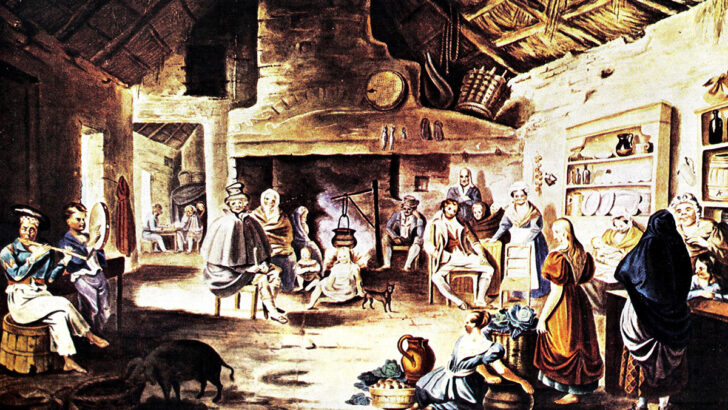This Listowel interior (pictured), a water colour rather than an oil, painted in 1842, is a picture with a story. It is attributed to a Miss Bridget Maria Fitzgerald (1817-1905), a lady with some local reputation as a painter.
It was come upon by the distinguished art historian Dr Anne Cruickshank, who photographed it in a big house in the Blackwater Valley in Co. Waterford. This must have been Dromana House, associated with a branch of the Fitzgerald family.
Knight of Glin
She passed her photograph on to the Knight of Glin, a Fitzgerald himself, who in turn gave it to Fr Gaughan for use in his landmark history of Listowel. It was thought to show a local squire being entertained in a shebeen.
Local historian Maurice G. McElligot questioned this use of the term “shebeen” (directly from the Gaelic síbín). But it is clearly not an ordinary house, what with the assorted people present and the bar. This curiously is very reminiscent indeed of the set-up at the opening of The Playboy of the Western World, as described by Synge.
“Country public house, very rough and untidy. There is a sort of counter on the right with shelves, holding many bottles and jugs, just seen above. Empty barrels stand near the counter. At the back, a little to the left, there is a settle with shelves above it, with more jugs and a table beneath the window. At the left there is a large open-fireplace, with a turf fire, and a small door into inner room.”
Here perhaps is an image of a playboy of the Southern World? It may not be selling illegal drinks or spirits, so may not strictly be a sheebeen, but it still seems to echo that illegal set up.
In any case it is a very interesting image of Irish socialising which echoes the atmosphere more of Ireland in the 18th Century than the first years of Victoria’s reign.
The art restorer James Gorry, owner of the Gorry Gallery in Dublin, a specialist on the art of this period, remarked to me that the picture was perhaps larger than realised, given the nature of the building, which is clearly something more than a cottage. The huge scale of the chimney suggests a former forge. In any matter, given such a record of low life is a rarity, it is, he says, of great interest, certainly a picture “of national importance”.
Such images are rare and it is vital they be preserved. One wonder where the original is now.
A great deal is made of Irish art in its most accomplished forms, but such high art was more often than not made for the prosperous merchant class, the landed gentry and the aristocracy. it did not involve ordinary folk at all.
Irreplaceable
Such images are irreplaceable evidence to a historian, but just rubbish to many of the present generation, some of whose memories hardly stray further back than the 1990s. It seems that as a nation, having abandoned the relics of saints, we are quite prepared to destroy the relics of our sinners as well. Will our great great-grandchildren forgive us?
If this picture can be traced there will surely be found a suitable wall for it somewhere in Listowel.
The Listowel Literary Week is being held at present. This is a truly popular festival of writing, poetry, music, history and talk. It is an event not bound up in the business of proving ‘tourist benefits for the local economy’, which is often all local and national agencies seem interested in promoting. It is an exciting event for all. Events can still be caught up with.
INFORMATION: Listowel Writers’ Week, 24 The Square, Listowel, Co Kerry, Ireland V31 RD93; Tel: +353 68 21074; Email: info@writersweek.ie.


 Peter Costello
Peter Costello A painting of a shebeen in Listowel by Miss Brigid Fitzgerald.
A painting of a shebeen in Listowel by Miss Brigid Fitzgerald. 